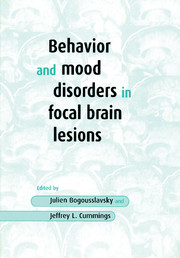Book contents
- Frontmatter
- Dedication
- Contents
- List of contributors
- Preface
- Acknowledgments
- 1 Emotional consequences of focal brain lesions: an overview
- 2 The evaluation of mood and behavior in patients with focal brain lesions
- 3 Methodological issues in studying secondary mood disorders
- 4 Emotional behavior in acute brain lesions
- 5 Depression and lesion location in stroke
- 6 Mood and behavior in disorders of the basal ganglia
- 7 Mania and manic-like disorders
- 8 Behavioral and emotional changes after focal frontal lobe damage
- 9 Disorders of motivation
- 10 Thalamic behavioral syndromes
- 11 Obsessive-compulsive disorders in association with focal brain lesions
- 12 Emotional dysprosody and similar dysfunctions
- 13 Temporal lobe behavioral syndromes
- 14 Neural correlates of violent behavior
- 15 Focal lesions and psychosis
- 16 Alterations in sexual behavior following focal brain injury
- 17 Anosognosia
- 18 Acute confusional states and delirium
- Index
Preface
Published online by Cambridge University Press: 05 August 2016
- Frontmatter
- Dedication
- Contents
- List of contributors
- Preface
- Acknowledgments
- 1 Emotional consequences of focal brain lesions: an overview
- 2 The evaluation of mood and behavior in patients with focal brain lesions
- 3 Methodological issues in studying secondary mood disorders
- 4 Emotional behavior in acute brain lesions
- 5 Depression and lesion location in stroke
- 6 Mood and behavior in disorders of the basal ganglia
- 7 Mania and manic-like disorders
- 8 Behavioral and emotional changes after focal frontal lobe damage
- 9 Disorders of motivation
- 10 Thalamic behavioral syndromes
- 11 Obsessive-compulsive disorders in association with focal brain lesions
- 12 Emotional dysprosody and similar dysfunctions
- 13 Temporal lobe behavioral syndromes
- 14 Neural correlates of violent behavior
- 15 Focal lesions and psychosis
- 16 Alterations in sexual behavior following focal brain injury
- 17 Anosognosia
- 18 Acute confusional states and delirium
- Index
Summary
As implied in the name, the central nervous system is a system of highly interconnected structures organized as parallel circuits of connected series of modules underlying complex human behavior and emotion. Despite the interconnected nature of the central nervous system, focal lesions produce distinctive behavioral changes and are highly instructive in terms of understanding both brain function and neurobehavioral syndromes manifested by individual patients. Studies with functional brain imaging have largely confirmed conclusions derived from observations based on the study of patients with focal lesions and investigation of brain injuries using structural and functional imaging.
The neuropsychological consequences of focal brain lesions have been relatively thoroughly studied. Memory disorders, aphasia, agnosia, apraxia, alexia, agraphia, and disorders of executive function have been intensely studied with neuropsychological and cognitive psychological approaches in the recent past. On the other hand, the emotional and behavioral consequences of focal brain lesions are more obscure and have been studied relatively little. This volume provides a comprehensive update of behavioral and emotional changes associated with focal central nervous system lesions. Abnormalities of mood, thought and affect processing, motivation, and sexual behavior are described. This volume summarizes the current state of research with regard to the behavioral and emotional consequences of localized brain lesions and provides the basis for further research and patient care.
- Type
- Chapter
- Information
- Behavior and Mood Disorders in Focal Brain Lesions , pp. xi - xiiPublisher: Cambridge University PressPrint publication year: 2000



